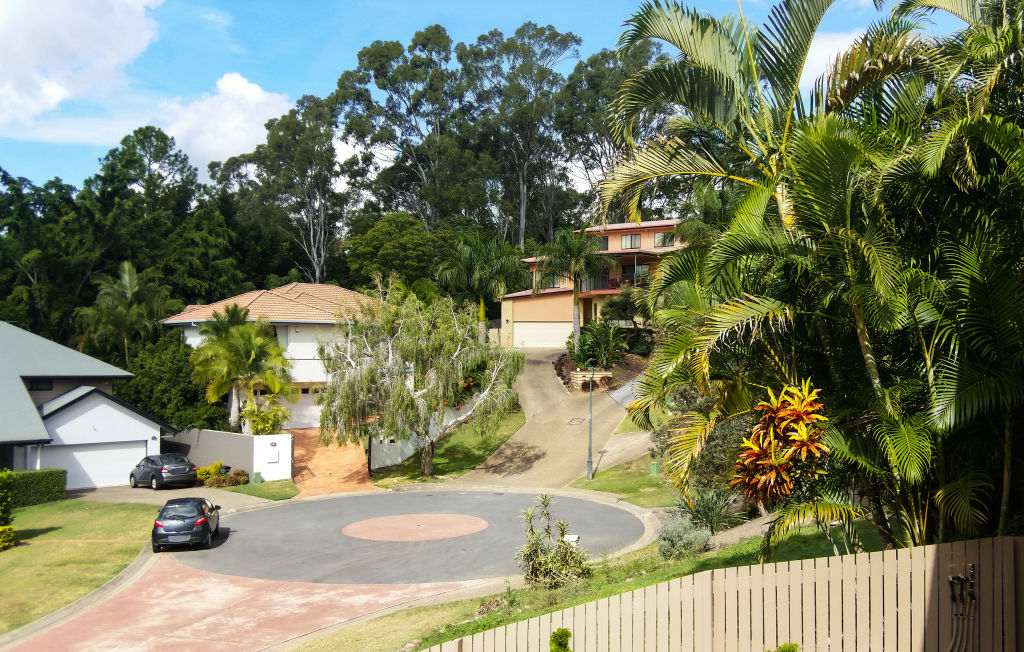
Cul-de-sac in Queensland Australia suburb with houses up on hills with steep driveways and tall gum trees behind and tropical landscaping Photo: Getty
Property investor red flags: what you need to know before you buy
Which are the most alarming red flags you might encounter when you’re looking at an investment property?
There are a number, say the experts, but you have to work out carefully which signals warrant further investigation, and which constitute a clear warning to stay well away.
“Front of mind at the moment is making sure it’s not in a flood zone,” says property investment strategist Lloyd Edge of Aus Property Professionals.
“Apart from the physical risk, there’s also the sharply rising cost of insurance.
“Other red flags include making sure a property is not on a busy road, but on a quieter street or in a cul de sac, and is preferably not out of the catchment area for good local schools, or not too far away from amenity. It’s also wise not to be right under a flight path.”

Heritage homes can be very appealing, but can have a host of structual and other issues, experts say. Photo: Greg Briggs
Professional building and pest inspections from reputable companies should never be skipped, either.
They could come up with potentially financially ruinous structural faults and, with all the recent rain in many states, large quantities of mould, and even black mould.
“It’s important to find out how bad that might be,” Edge says.
“An expert plumber they might say it’s easy to clean up and sort out, so you could use that in a negotiation with the vendor over price. Or they might say it’s endemic, in which case it could be a health risk, and it’s better not to buy.
“There are around 600,000 properties for sale in Australia across 15,000 suburbs at any one time, so there’s plenty to choose from.”

Apartments and townhouses should undergo a strata inspection before purchase, experts say. Photo: Steve Woodburn
Water damage can be very expensive to fix, and sometimes building inspections won’t reveal it if it’s concealed behind an inside wall, says Stephen Timm, the managing director of Home-in, a buying concierge advising on home purchasing.
“So it’s important to look out for small indications, like a freshly painted wall when others haven’t been painted,” he says.
“Illegal or unapproved building works is another danger, like a pergola out the back that looks as if it’s not the type that would be approved.
“With so many reno shows on TV, it’s been said that up to a third of homes now have illegal or unapproved building work. It’s also critical to check state regulations on rental properties – for instance, new Victorian standards around ventilation and dampness.”

Experts say homes in areas prone to flooding and natural disasters will attract high insurance costs. Photo: Getty
For apartments and townhouses under strata title, a good strata inspection is also something that should never be compromised on, says Matt Trachtenberg-Ray, the director of independent inspection company I&D Strata Searching.
“There are obvious things like structural problems and any upcoming costs that don’t look like they’ve been budgeted for in the capital works fund,” he says.
“Many buildings have prepared reports on their capital works programs and, while some are diligently acting on their recommendations, some aren’t following them.

Homes in flood zones should be avoided, property investment strategist Lloyd Edge says. Photo: Getty
“For some investors, an upcoming $30,000 special levy could be an investment, and written off on tax, but not for others, while another red flag might be ordered from regulatory bodies, like fire orders.
“Similarly, some people might like heritage buildings but there can be significant costs involved for any work that needs to be done, engaging heritage architects.”
Article by Domain.com.au
